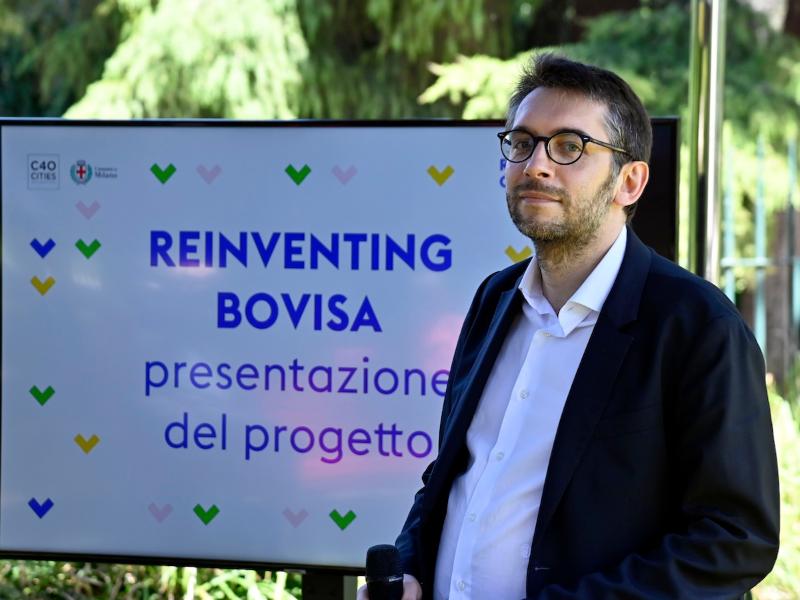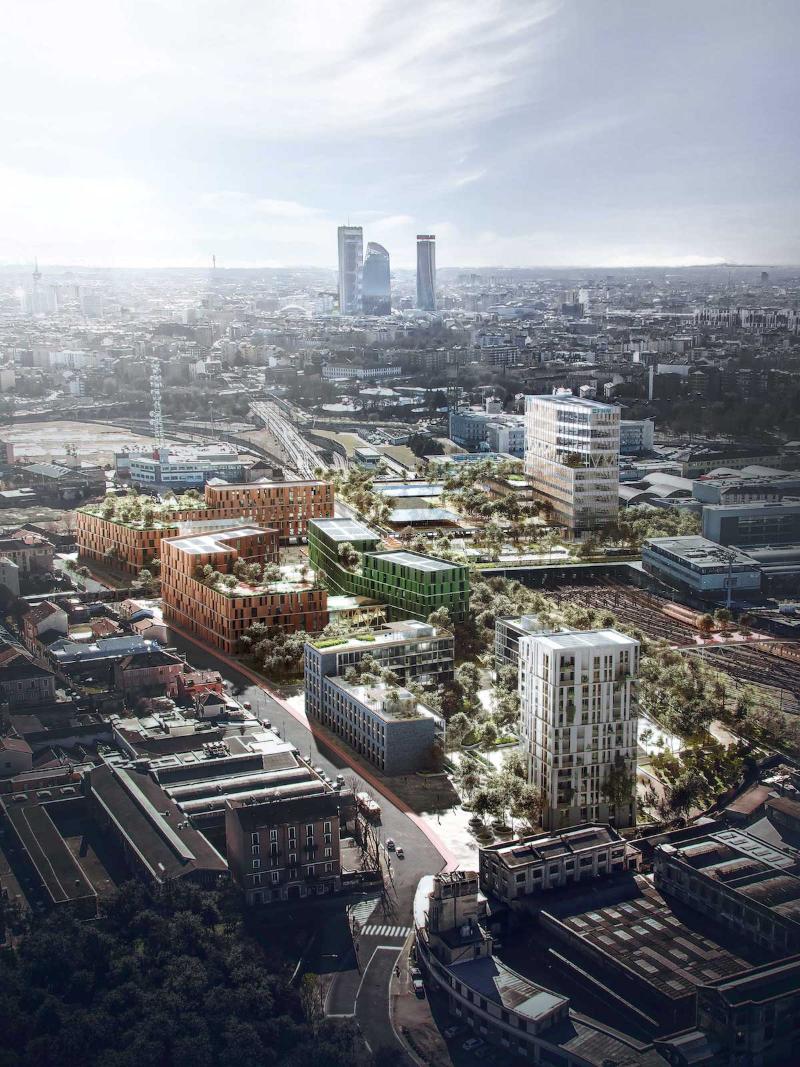Reinventing cities. Nodo Bovisa, an urban laboratory for sustainable and integrated mobility alive 7 days a week
Reinventing cities. Nodo Bovisa, an urban laboratory for sustainable and integrated mobility alive 7 days a week
Enhancement of public transport, accommodation and services for students, cycle and green routes, a system of squares: it is MoLeCoLa, the first place in the international tender - Photo gallery
Milan, May 20 2021 – A model interchange hub between rail mobility, public transport and smart mobility, capable of reconnecting the areas to the east and west of the station; a settlement complementary to the university campus and the new technological district that the Polytechnic of Milan will create in the Goccia area; a community project, where residents and students activate the set of new buildings and services; a laboratory, intended as a pilot space, to test new technological solutions. In short, it is MoLeCoLa (Mobility, Learning, Community, Lab), the project for the Bovisa hub most appreciated by the Jury of the second edition of Reinventing cities, the international tender announced by the Municipality together with C40 which provides for the alienation or establishment of the right of surface area of sites to be allocated to sustainable urban regeneration projects.
The proposal was presented by Hines with the support of Park associati, Habitech, ESA Engineering, Bollinger+Grohmann, Mobility in chain, Greencure, Institute for Social Research (IRS), Schneider electric, A2a Calore eservizi, Woodbeton and Ammlex. The Municipality of Milan and FNM SpA are now evaluating some technical and economic aspects to decide whether to proceed with the award of the tender for this specific area.
"The regeneration of Bovisa is one of the strategic pieces of Milan 2030 – declares the councilor for urban planning Pierfrancesco Maran –. We are talking about a neighborhood with enormous potential, characterized by a lively cultural and social ferment and an increasingly marked university vocation. The development of the hub, with the strengthening of the railway and the recovery of abandoned areas, together with the major projects of the Polytechnic for the expansion of the Campus and the creation of a park of over 300.000 m2, represent an extraordinary opportunity to mend disconnected parts of the territory and strengthen the station as a reference point for mobility, creating a strong connection along the axis that from Porta Nuova and Scalo Farini reaches Mind and Cascina Merlata. We therefore trust that the conditions will be created to carry out this project."

"With the Reinventing cities program, we want to create a virtuous space for public-private collaboration: where the private sector can interact and collaborate with the city, through projects with high environmental standards that look at the communities, the challenges of the territory and which are in line with Milan's strategies and ambition for the next few years. The Reinventing cities projects enhance public space and act as a symbol for the future we want in cities - declares Costanza De Stefani, C40 Reinventing cities Project officer".
MoLeCoLa was born from the need to mend the urban fabric of the city currently divided by the route of the railway tracks. The Bovisa station becomes a key element around which the new district unfolds also thanks to the construction of four new tracks which will increase its strategic importance in the Milanese railway system. From a place of passage, crossed but not experienced, the train station area becomes a multimodal hub at the center of a new neighborhood alive and active all hours of the day and every day of the week, through the valorization of public space and the creation of squares, gardens, cycle paths, green areas and more than 750 trees, sports fields, dehors.
The masterplan is spread over an area of approximately 90.000 m2 along the east-west axis and along the north-south axis, creating a widespread system of connections and public spaces in the neighborhood. The connection between the areas of Bovisa and Villapizzone is guaranteed by two new cycle/pedestrian routes: the first runs along via Andreoli and crosses the neighborhood transversally, crossing the railway parallel to the tram line to continue west along via Lambruschini; the second, further north, allows a further bypass of the railway for soft mobility, putting the MoLeCoLa sector in direct connection with the new development of Bovisa-Goccia.
Three new connections are also activated along the north-south axis, designing routes with different landscape and mobility characteristics: a driveway along Via Bovisasca, a cycle/pedestrian promenade in the center of the lot and a walk surrounded by greenery in the strip that runs along the railway. A tree-lined boulevard will also connect the three squares which will activate an urban street, joined together by a tree-lined avenue along which the tram line extends together with a cycle/pedestrian path. The three environments have different characteristics: Piazza Alfieri has been redesigned as a space for organizing temporary activities by taking advantage of the size of the public space and the wooden roof which allows it to host markets and other functions at any time of the year; the station square is designed as an interchange node between all the different mobility possibilities offered by MoLeCoLa - tram, cycle path and velo station, parking areas for sharing scooters and bicycles, railway station -, the square along via Lambruschini is instead conceived as a new entrance door to the area to the west of the station, a space dedicated to the students of the Via La Masa campus and the new reality of the Goccia.
The project involves the construction of two student residences and new accommodation, with a wide range of rental solutions dedicated to students, young workers or professionals, even for short periods. The buildings are developed in a courtyard and are connected by large green areas, play areas for children, vegetable gardens, multipurpose and sports spaces. Coworking spaces, commercial activities and neighborhood services are created on the ground floors, with a view to a city 15 minutes away. The construction of the company's new headquarters is planned in the areas owned by Ferrovienord. All the buildings have been designed with entirely wooden structures, removable with reduced environmental impact, equipped with a district heating and cooling system, photovoltaic panels and green roofs.
MoLeCoLa is a predominantly pedestrian district, which promotes electric mobility among residents, workers and visitors of the neighborhood through the provision of infrastructures for vehicle charging, dedicated parking and other incentives. The project complies with LEED for Neighborhood certification, the sustainability certification protocol that evaluates not only the energy performance of a neighborhood, but also the use of water resources, the impact of new buildings in the existing context, efficiency and the presence of green spaces, pedestrian areas and community spaces. The activation of participatory processes is envisaged to intercept the needs of the community, listening to students, sports associations, cultural and commercial entities in the neighbourhood. The goal is to complete the work by 2026.
The rebirth of the Bovisa Node is part of the ambitious ongoing regeneration project of the entire neighborhood, driven by the expansion of the Polytechnic University of Milan. In fact, as foreseen by the local government plan, the Bovisa-Goccia area will be regenerated starting from the expansion of the university campus, also through the recovery of valuable buildings such as the two former gasometers, and the creation of a large system of green on approximately 65% of the entire surface (325.723 m2). The experimental “DENG” building will also be built, intended to house the Department of Energy.
The transfer of some managements of the Municipality of Milan is also underway in a former building of the Polytechnic, in via Durando 38, as part of the reorganization of the offices.

Updated: 12/06/2021
